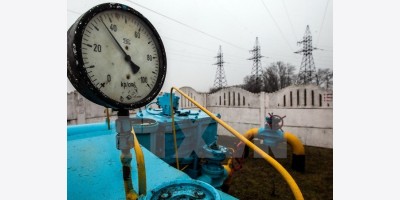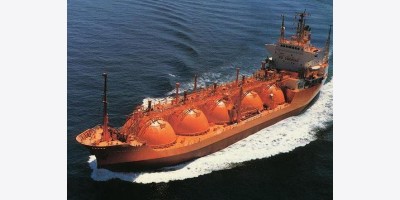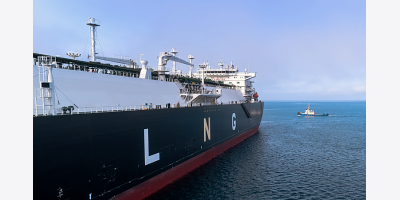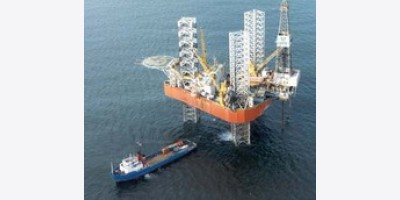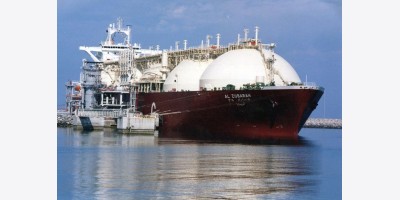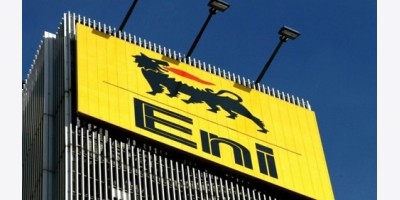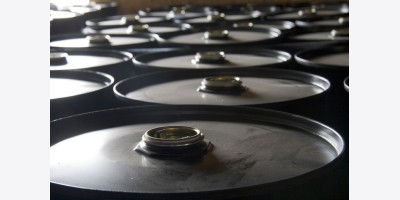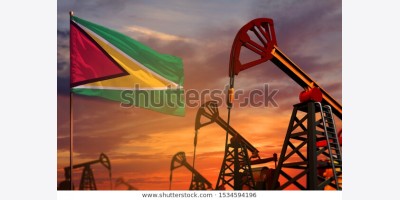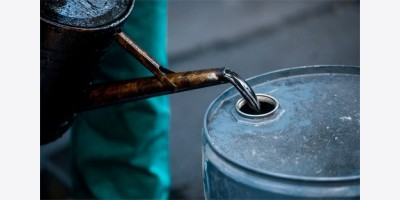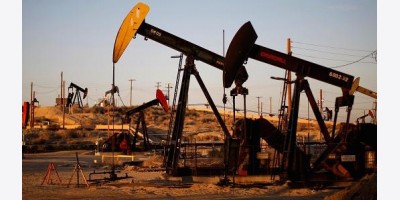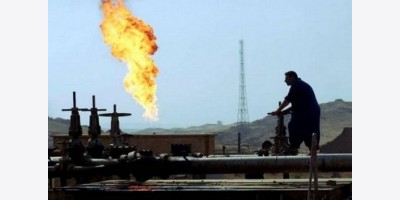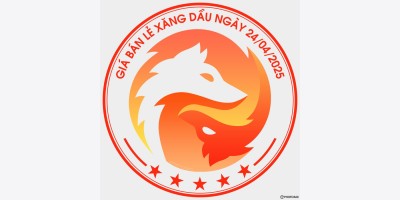Baker Hughes Talking With Halliburton About Possible Deal
Halliburton Co. (HAL), the world’s second biggest provider of oilfield services, is in talks to buy No. 3 Baker Hughes (BHI) Inc. in what would be one of the largest takeovers of a U.S. energy company in years.
Baker Hughes rose 15 percent to close in New York at $58.75 a share, giving the company a market value of more than $25 billion. Halliburton rose 1.1 percent to $53.79, giving it a market value of about $46 billion.
A combination of Halliburton with Baker Hughes would be a little more than half the size of larger rival Schlumberger Ltd. The deal will probably be closely scrutinized by federal anti-trust regulators, especially where the two companies’ businesses overlap most in North America.
With Baker Hughes, Halliburton fills a gap in its portfolio of oilfield services: technology to boost production in aging wells. Halliburton also gets Baker Hughes’ prized oil tools business.
“These oilfield services companies need to have a global footprint of a complete portfolio of products and services,” Richard Spears, vice president at Tulsa, Oklahoma-based industry consultant Spears & Associates said in a phone interview. “Schlumberger has it; a Halliburton-Baker Hughes combination would mimic the Schlumberger footprint.”
Confirming Talks
In a statement today, Baker Hughes said it is in “preliminary discussions” with Halliburton about a “potential business combination.”
A deal could be announced as soon as next week, said one person familiar with the matter, asking not to be identified discussing private information. Halliburton doesn’t comment on market speculation, Emily Mir, a spokeswoman at Halliburton, said in an e-mail.
By eliminating a competitor, Halliburton would gain market clout at a time when oil prices are plunging, insulating it from a sustained downturn, said Ed Hirs, who lectures on energy economics at the University of Houston.
“Halliburton and Baker Hughes would have been competing more strenuously to maintain market share in the downturn, but this will make that easier,” Hirs said.
Halliburton initiated talks by contacting Baker Hughes several weeks ago, said one of the people with knowledge of the talks. Both companies are hired by oil and natural gas explorers to drill wells and provide services such as hydraulic fracturing, or fracking, which cracks rock to let petroleum flow more freely.
Anti-Trust Questions
Discussions of late have focused on potential anti-trust issues and Halliburton has explored options such as setting up a unit to hold assets it’s willing to divest, this person said. If the deal is completed, Halliburton and Baker Hughes will probably announce to regulators a willingness to sell assets to overcome anti-trust concerns, the person added.
Halliburton may have to divest more than 20 percent of Baker Hughes to clear regulatory scrutiny, this person added.
Combined, the companies would dominate the $25 billion U.S. onshore fracking market with a 39 percent market share, more than double the size of its next competitor, Schlumberger, according to industry consultant Spears & Associates.
It’s unlikely the deal could make it through the U.S. Department of Justice without “something having to be carved off,” said Edward Muztafago, an analyst for Societe Generale in New York.
Largest Deal
Baker Hughes would be Halliburton’s largest acquisition, topping a 1998 purchase of Dresser Industries Inc. for about $8 billion, data compiled by Bloomberg show. Halliburton’s $14 billion in deals has lagged Schlumberger’s $27 billion in takeovers, the data show.
The takeover could be the largest of a U.S. oil services company, data compiled by Bloomberg show, and potentially the largest in the energy sector since Kinder Morgan Inc. (KMI) said in August it would acquire all of Kinder Morgan Energy Partners LP, Kinder Morgan Management LLC and El Paso Pipeline Partners LP in a series of transactions valued at about $44 billion.
Oil prices dropped to four-year lows today as booming U.S. crude production combines with a shrinking forecast of demand growth. Lower prices could curtail drilling, meaning lower sales for Halliburton and its peers.
Prices should bottom out next year and begin climbing again, Dave Lesar, chief executive officer at Halliburton, said Oct. 22 in an interview from his Houston headquarters.
Rising Earnings
Halliburton reported third-quarter earnings that climbed 70 percent from a year earlier, and is expected to boost earnings 30 percent this quarter. The company, which has doubled its quarterly dividend over the past two years, reported cash of $2 billion at the end of the third quarter.
Baker Hughes said earnings rose 10 percent in the third quarter.
Credit Suisse Group AG is advising Halliburton on the talks while Goldman Sachs Group Inc. is advising Baker Hughes, one of the people said. Representatives for both banks declined to comment.
The Wall Street Journal reported the talks earlier.
OPEC Diplomacy Picks Up With Iraq-to-Libya Chiefs
OPEC producers are stepping up their diplomatic visits before the group’s meeting in two weeks, potentially seeking a consensus on how to react to oil prices that have plunged to a four-year low.
Libyan Prime Minister Abdullah al-Thani flew to Riyadh yesterday just as Iraqi President Fouad Masoum left the kingdom after a two-day visit where he met with King Abdullah, the official Saudi Press Agency reported. Rafael Ramirez, Venezuela’s foreign minister and representative to OPEC, held talks in Algeria and Qatar. Saudi Arabia’s Oil Minister Ali Al-Naimi toured Latin America.
“The Saudis will not walk the road alone, they want to see everyone share the burden with them,” Kuwait-based analyst Kamel al-Harami said by phone. Saudi Arabia, the world’s biggest oil exporter, is trying to build consensus among fellow members of the Organization of Petroleum Exporting Countries before they meet Nov. 27 in Vienna, he said.
Brent crude extended losses below $80 a barrel, dropping to a four-year low amid signs that OPEC’s biggest members will refrain from reducing output to ease a supply glut. WTI fell below $75 yesterday.
Falling oil prices are straining state budgets among OPEC members, including Iraq’s government, which is leading a costly war against Islamist militants, and Libya that is struggling to keep crude output steady amid political divisions and violence.
Iran’s Message
Iran’s Islamic Republic News Agency said Bijan Zanganeh, the nation’s oil minister, delivered a message to Kuwait on behalf of President Hassan Rouhani. Zanganeh briefed Kuwaiti Emir Sheikh Sabah Al-Ahmad Al Sabah on developments in oil markets, the agency said. He also went to Qatar, IRNA reported.
Algeria and Venezuela discussed oil markets and re-affirmed a joint position to defend prices, state-run news agency Algeria Press Service cited visiting Venezuelan Foreign Minister Rafael
Ramirez as saying after a meeting in Algiers with Abdelaziz Bouteflika, the north African country’s president.
He also went to Qatar where he discussed crude prices and stability of oil markets with Middle East country’s Prime Minister Abdullah bin Nasser bin Khalifa Al Thani and Energy Minister Mohammed Bin Saleh Al Sada yesterday in Doha as part of a tour of oil-producing countries, Venezuela’s foreign ministry said in statement on website. He’s also is scheduled to travel to Iran and Russia, the ministry said.
All or Nothing
Saudi Arabia remains committed to seeking a stable oil prices and speculation of a battle between crude producers has no basis, Al-Naimi said Nov. 12 in Mexico after a visit to Venezuela.
OPEC members Libya, Venezuela and Ecuador have called for action to prevent crude from falling further. Libya’s OPEC governor Samir Kamal said last month that the group must cut daily output by 500,000 barrels as the market is oversupplied by about 1 million barrels a day.
“They can all come to Saudi Arabia and ask the Saudis to support oil prices, but that will not change anything,” al-Harami said. “At the next meeting, Naimi will look for a cut by all the members and if he doesn’t get it, nothing will change.”
Microsoft Tops Exxon as 2nd Biggest Company on Oil Drop
Exxon Mobil Corp. (XOM) ceded its title as the world’s second-largest company to Microsoft Corp. after the five-month oil rout cut $47 billion from its market value.
Exxon, based in Irving, Texas, slipped 0.8 percent to $94.66 at 4 p.m. in New York, dropping for the third time in four days and reducing its overall value to $400.8 billion. Microsoft, in Redmond, Washington, climbed 1.7 percent, extending an advance from its October bottom to 16 percent, pushing its capitalization to $408.9 billion.
The flip-flop follows a 30 percent plunge in crude spurred by rising U.S. supplies and a refusal by OPEC to reduce output. Computer and software makers in the Standard & Poor’s 500 Index have posted the third-largest gains among industries this year besides health-care and utilities, rising 17 percent.
“Nothing stays the same forever, and the stronger dollar with weaker oil prices has been the catalyst for this,” Quincy Krosby, a market strategist at Prudential Financial Inc. in Newark, New Jersey, said by phone. The firm oversees more than $1 trillion. “Larger-cap tech stocks have become a place that investors are going to as a source for dividends and buybacks, and in some cases, safety.”
Apple Shares
Apple (AAPL) Inc., the Cupertino, California-based iPhone maker, retains its rank as the world’s biggest company. Its shares have rallied 41 percent in 2014, the 33rd biggest gain in the S&P 500, as the company bought back shares and extended a streak of beating analyst earnings estimates to eight quarters.
It isn’t the first time Exxon has been superseded by a technology company in the No. 2 slot. Google Inc., operator of the world’s most popular search engine, surpassed its market value for four days in February and two in March, rising as high as $410 billion. Its 0.8 percent retreat in 2014 has pushed it down to about $373 billion as of today.
Microsoft (MSFT) has climbed 33 percent this year, adding almost $100 billion to its equity value, as its new chief executive officer, Satya Nadella, began his effort to revive the company. The world’s largest software maker last month reported quarterly sales that topped analysts’ estimates, driven by cloud-computing growth and recovering personal-computer sales.
Web Services
The results bolstered Nadella’s view that Microsoft needs to focus on Web-based services and mobile devices. The CEO, who took over in February, is cutting 18,000 jobs and lowering costs as it seeks to streamline operations.
Exxon has fallen 6.5 percent in 2014 amid a 4.1 percent decline for energy companies in the S&P 500. Better-than-forecast earnings have been unable to stem the decline spurred by falling oil. Even after beating analyst profit estimates in the third quarter, the stock has fallen 2.1 percent as investors questioned how long they can continue to outrun falling oil prices.
“We’re seeing a precipitous slide in oil, and Exxon has suffered,” Drew Wilson, an investment analyst with Fenimore Asset Management in Cobleskill, New York, said in a phone interview. “At the same time Microsoft is gaining more credibility than it’s had in the past with a change at the top and some relative successes. The confluence of those things is what’s causing the shake-up.”
U.S. Envoy Sees Risk of Ukraine Spinning Out of Control
The crisis in Ukraine is at risk of spinning out of control, a top U.S. diplomat said, as European leaders remained split over imposing deeper sanctions on Russia for backing a rebellion that’s killed thousands of people.
Russia must stop violating a Sept. 5 cease-fire agreement signed in Minsk, Belarus, Samantha Power, U.S. Ambassador to the United Nations, told journalists today, citing a growing number of military convoys in Ukraine’s rebel-held regions and increased shelling of the Donetsk airport. Ukraine’s foreign minister said his country is prepared to defend itself after NATO warned Russia was sending combat troops across its border. Russian President Vladimir Putin denies military involvement.
“Is there a risk that the situation is getting out of control? Yes, there is that risk,” Power said. It’s “an extremely worrying period.”
Waging Financial War
The conflict is threatening to return to the open warfare seen before the shaky truce was signed, with Ukraine’s government and pro-Russian separatists accusing each other of preparing for new assaults. More than 4,000 people have died since the fighting began in mid-April, according to UN estimates, in what’s become the worst geopolitical standoff between Russia and its former Cold War foes since the Iron Curtain fell 25 years ago.
Ukraine Ready
The self-proclaimed Donetsk People’s Republic called for an immediate meeting of the Minsk group today, which includes representatives from the rebels, the Organization for Security and Cooperation in Europe, Ukraine, and Russia, the DPR’s representative in the talks, Denis Pushilin, said in a statement on the group’s website. Earlier in the day he said a new meeting could take place in 10 days.
Russia is massing soldiers and military equipment in eastern Ukraine, U.S. Air Force General Philip Breedlove, NATO’s top military commander, said yesterday.
“The situation on the ground is very tense,” Ukrainian Foreign Minister Pavlo Klimkin said in an interview with Bloomberg Television today. Asked whether he expects an attack, Klimkin said: “We are of course prepared.”
While European Union governments are discussing new actions, they will limit any near-term moves to asset freezes and travel bans on additional Ukrainian separatists, according to EU officials and a planning document.
The bloc’s foreign-policy chief, Federica Mogherini, said a Nov. 17 meeting of national ministers will consider the blacklisting while putting off a discussion of tougher economic measures until next month’s summit of leaders.
Blacklist Only
An “eventual discussion” of economic restrictions is for EU heads of government, she said, Mogherini said in a letter to foreign ministers obtained by Bloomberg News.
The conflict has sent both Russian and Ukrainian assets weaker. Ukraine raised its discount rate by 1.5 percentage point to 14 percent yesterday, the highest level since 2001, the central bank said in a statement yesterday. The hryvnia gained more than 2 percent to 15.53 against the dollar at 5:28 p.m. in Kiev today, according to data compiled by Bloomberg. The ruble lost 2 percent and was trading at 46.48 per dollar.
Russian President Vladimir Putin is due to meet with fellow leaders from the Group of 20 nations in Australia this weekend. British Prime Minister David Cameron cited the prospect of a new Cold War in a speech in London on Nov. 10, saying the U.K. will “keep upping the pressure” and he’d make clear to Putin that Russia will have “radically” different ties with the rest of the world if it continues on its path.
Fighting Escalates
Russia blames the diplomatic standoff on the U.S. and the EU. Anti-Russian sentiment and the Ukrainian conflict were creating a “difficult” situation on the country’s southwestern border, Russian Defense Minister Sergei Shoigu said yesterday, adding that his country will send long-range air patrols as far as the Gulf of Mexico and the eastern Pacific Ocean.
Two Dutch F-16 fighter jets on a NATO mission intercepted a Russian aircraft that entered the airspace of the Baltic states, the Dutch Defense Ministry said on its website today. NATO says interceptions in 2014 have now reached 100, three times last year’s total.
Russia will send 82 aid trucks to eastern Ukraine tomorrow, Alexander Lukashevich, spokesman for the Foreign Ministry in Moscow, said in a televised briefing today.
Ukrainian troops killed as many as 20 rebels and destroyed about 10 separatist military vehicles near the city of Horlivka in Donetsk region today to prevent an attack on the town of Dzerzhynsk, the Defense Ministry said on Facebook.
In the Ukrainian capital Kiev, military spokesman Andriy Lysenko said fighting was escalating in occupied areas. Shelling by pro-Russian rebels at government troops was most intense in the Luhansk region, he said.
Expanding EU sanctions is difficult as they require unanimity among the 28 governments, reducing the prospects of new decisions on Monday at the first foreign ministers’ meeting led by Mogherini. The ministers could set in motion a decision to expand the 119-name blacklist later next week, an EU official told reporters.
Expanding the blacklist could backfire, Mogherini said. “The main separatist leaders are already listed” and “the targeted separatists could be at some point agents in the implementation of the peace plan,” she said in the letter.
Mogherini’s approach has been echoed by German Chancellor Angela Merkel, who said on Nov. 11 that while the blacklist might be expanded, “further economic sanctions aren’t planned for the moment.”
Kurds Gain Economic Freedom From Baghdad as Oil Exports Rise
Iraqi Kurdistan is gaining financial independence from Baghdad as it exports enough oil to pay its own way.
The Kurdistan Regional Government, or KRG, is shipping directly to Turkey in defiance of the central government, which started withholding its share of state revenue in January in retaliation. Despite that, growing export earnings mean the Kurds last week promised regular payments to producers including Genel Energy Plc (GENL) and Gulf Keystone Petroleum Ltd. (GKP), providing a boost to the local oil industry.
“We now have demonstrable evidence that exports from the KRG through Ceyhan is creating a sales channel, which is robust and working well for all parties,” Genel’s Chief Financial Officer Julian Metherell said over the phone today, referring to the Turkish port where Kurdish oil is loaded onto tankers.
“We’ve now had almost 30 cargoes sold and that money is being repatriated to the KRG and is also being used to pay the contractors,” he said.
The Kurds’ efforts to export crude independently have provoked legal action by the central government and fanned speculation that the region will pursue greater autonomy. The KRG and Baghdad are seeking to resolve their dispute after forming a battlefield partnership to repel Islamic State, the militant group that has seized swathes of OPEC’s second-biggest producer since June.
Seeking Solution
The KRG announced today that it would put 150,000 barrels of crude a day at the disposal of the central government, and that Baghdad would transfer $500 million to the regional authority as the two sides seek to resolve their differences. Kurdistan Prime Minister Nechirvan Barzani will lead a delegation to Baghdad in coming days to discuss a solution, it said in a statement on its website.
Exports are set to rise from 300,000 barrels a day to 500,000 barrels in the first quarter, according to the KRG. At that rate, they would account for about 17 percent of Iraq’s oil exports -- the same proportion of the country’s revenue the central government has been withholding, making the region financially independent of Baghdad, said Julian Lee, an oil strategist for Bloomberg First Word who has worked in the industry for 25 years.
The KRG could keep the money in lieu of its share of state revenue, Lee said.
“I don’t think Baghdad would be happy with this type of arrangement, as it would effectively be one step closer to Kurdish independence and the breakup of Iraq,” he said.
Taq Taq
Production capacity from Genel’s Taq Taq and Tawke fields is set to rise to about 400,000 barrels a day in the first half from output of 234,000 barrels as of September, according to the company. Norway’s DNO ASA (DNO) owns a 55 percent stake in Tawke.
“We have one foot on the accelerator, one foot on the brake,” DNO’s Executive Chairman Bijan Mossavar-Rahmani said in an interview in Oslo today. “If the payments don’t come for some period of time, we’ll hit the brake. If the payments come more regularly, we’ll slam the accelerator.”
Gulf Keystone seeks to increase output by 74 percent to 40,000 barrels a day by the end of the year, and plans to boost production to about 65,000 barrels to 70,000 barrels within two years once it secures regular export payments, Chief Executive Officer John Gerstenlauer said over the phone today.
“The operation is going in an excellent fashion, the business is in an excellent shape,” he said. The KRG “committed themselves for steady payment going forward. That’s a big step for them. It’s very encouraging.”
The KRG owes Gulf Keystone about $250 million for oil shipments and investments, he said. The government last week said it would start regular payments to producers, with an initial $75 million payment this month.
Making Progress
The KRG has exported 34.5 million barrels of oil at a value of $2.87 billion since January, it said in a statement last week. It received $2.1 billion in cash and $775 million worth of oil products, such as kerosene and diesel. The sum accounts for “only a fraction” of KRG’s annual share from Iraq’s 2014 budget, it said.
Michael Howard, an adviser to the KRG’s minister for natural resources, didn’t reply to e-mails and a call to his mobile phone.
“With multiple cargoes shipped and paid for, this route to market for Kurdish oil, which bypasses Iraqi infrastructure, is being legitimized,” Daniel Ekstein, an analyst at UBS AG, said in a report this week. “Record production levels confirm contractors are making good operational progress.”
Genel today announced a deal with Iraq’s Kurdistan to develop Miran and Bina Bawi gas fields and agreed to buy OMV AV’s stake in Bina Bawi for $150 million as Turkey said the country plans to build a pipeline to import the fuel.
Pipeline Extension
Turkey plans to build a pipeline extension to the Iraqi border to import gas from the Kurdish region, said two Turkish officials with knowledge of the matter who asked not to be identified as the information isn’t public. It would carry as much as 20 billion cubic meters of gas a year, one of them said.
The KRG last year signed a deal to deliver Turkey 4 billion cubic meters of gas annually from 2017, rising to 10 billion by 2020, Genel said in August. Today’s deal gives the KRG an “ability to fulfill export commitments to Turkey under the Gas Sales Agreement,” Genel said.
Turkey, which imports about 60 percent of its 46 billion cubic meters of annual gas needs from Russia, wants alternative sources to reduce risks in its energy supply security. The country imports almost all its gas.
Sub-$2-a-Gallon Gasoline Futures Hand U.S. Motorists Gift
U.S. drivers will have some extra money in their pockets this holiday season as gasoline futures tumbling below $2 a gallon mean lower prices at the pump.
“The drop in futures is eventually going to translate into further declines at the pump,” Tim Evans, an energy analyst at Citi Futures Perspective in New York, said by phone yesterday. “There will be a little extra discretionary spending that consumers can use somewhere else this holiday season.”
The nation’s largest motoring club says retail prices “have a very good chance” of being the lowest for the Nov. 28 Thanksgiving holiday in five years. Motorists are already paying the least since 2010 after crude oil tumbled more than 20 percent in the past four months.
Gasoline futures dropped 10.54 cents, or 5 percent, to $2.0016 a gallon in New York yesterday, the lowest settlement since September 2010. The average retail price for regular gasoline fell 0.6 cent to $2.917 a gallon on Nov. 12, the least since December 2010, according to Heathrow, Florida-based AAA.
Based on the drop in the futures market, pump prices could fall to $2.70 or thereabouts, Michael Green, a Washington-based spokesman for AAA, said by telephone yesterday. “At this point, the market refuses to stabilize, the price of crude oil continues to fall and refiners are making more gasoline. There’s no end in sight.”
Gasoline Inventories
Almost one-fourth of filling stations in the U.S. are selling gasoline for less than $2.75 a gallon, Green said. Less than 1 percent are under $2.50, he said.
“We’re still a long way from getting down to $2,” Green said. “But I didn’t think it was going below $3, and here we are.”
Spot gasoline dropped at regional hubs across the U.S. yesterday. Conventional gasoline blendstock in the Gulf Coast slid 6.5 cents a gallon to a 17-cent discount versus futures traded in New York, data compiled by Bloomberg at 3:32 p.m. East Coast time yesterday showed. The fuel dropped 2.13 cents in New York and 1.25 cents in Los Angeles.
The drop in futures prices accelerated yesterday after a government report showed U.S. gasoline inventories increased last week as refineries boosted operating rates ahead of the Northern Hemisphere winter when heating demand climbs. Stockpiles rose 1.81 million barrels to 203.6 million in the week ended Nov. 7, the Energy Information Administration said.
Refining Capacity
Refineries operated at 90.1 percent of their capacity last week, up 1.7 percentage points from the previous week and the highest level since the seven days ended Sept. 19, according to the EIA, the Energy Department’s statistical arm. U.S. refiners usually schedule maintenance for September and October as they transition to winter from summer fuels.
“When refineries are running at 90 percent you are going to see gasoline supplies rise,” Bill O’Grady, chief market strategist at Confluence Investment Management in St. Louis, which oversees $2.4 billion, said by phone yesterday. “They want to make distillate fuel to meet demand both here and in Europe this winter, which means there will be a lot of unwanted barrels of gasoline produced.”
A Shell filling station in Spring, Texas, was selling the cheapest gasoline as of 4:46 p.m. New York time yesterday at $2.29 a gallon, Patrick DeHaan, a Chicago-based senior petroleum analyst for GasBuddy Organization Inc., said by e-mail.
“The likelihood of $2 gasoline still is quite some distance away, but the chances of it got a big boost today with oil shedding almost $3 a barrel and RBOB declining 10 cents a gallon,” DeHaan said yesterday. “If it were to happen, it won’t happen until December, if at all.”
Oil Tankers Stream Toward China as Price Drop Sparks Boom
The price plunge has spurred China, the world’s second-biggest importer after the U.S., to accelerate bookings of oil cargoes. It will also shave almost $20 billion a year in fuel costs across the maritime industry if prices that dropped 18 percent since last November hold around current levels, according to data compiled by Bloomberg.
While the oil slide is hurting nations from Saudi Arabia to Iran that depend on energy for revenues, companies including airlines and cement makers are benefiting as their fuel costs decline. Ship owners serving the industry’s benchmark Middle East-to-Asia trade routes are reaping the best returns from charters in years as the slump drives down the industry’s single biggest expense.
Oil Prices
“We’ve seen the Chinese buying a lot from the Middle East and that’s really let rates cook,” Erik Stavseth, an analyst at Arctic Securities ASA in Oslo whose recommendations on shippers returned 15 percent in the past year, said by phone Nov. 11. “With oil prices low going into winter, that’s likely to continue.”
The number of supertankers sailing toward China’s ports matched a record on Oct. 17 and is still close to that level now. The country added 35 million barrels to its inventories in the past three months as the nation fills its strategic petroleum reserves, OPEC said yesterday.
Active Traders
Brent crude has plunged amid speculation that Saudi Arabia and other members of the Organization of Petroleum Exporting Countries won’t respond to a global surplus by making the necessary supply cuts. The contract traded below $80 a barrel yesterday for the first time in four years, and ended at $77.92 today, down from a 2014 peak of $115.06.
China National United Oil Co., a unit of the country’s biggest energy company, bought a record of about 21 million barrels of Middle East oil in October, according to data compiled by Bloomberg from a pricing window organized by Platts, a unit of McGraw Hill Financial Inc.
“The Chinese, among others, seem to be responding to the lower oil price with additional demand,” Paddy Rodgers, the chief executive officer of Euronav NV (EURN), an Antwerp-based owner whose fleet is part of the world’s largest pool of tankers, said by e-mail Nov. 10.
Robert Hvide Macleod, the chief executive officer of the management unit of Frontline Ltd., the tanker company led by billionaire John Fredriksen, said he was unable to comment.
Shares of Euronav closed down 0.1 percent at 8.79 euros on the Euronext Brussels exchange, extending this year’s decline to 5 percent. Frontline gained 0.2 percent in Oslo today.
Biggest Expense
Oil companies booked ships to load 148 million tons of Persian Gulf crudes in the 12 weeks since Brent fell below $100 a barrel. The orders are up 5 percent from a year earlier, according to lists of charters compiled by Bloomberg.
The shipping industry consumes as much as 3.5 million barrels a day in fuel, according to Trafigura Beheer BV, an oil trader. Prices averaged about $73 a barrel on Nov. 11, about $15 a barrel less than a year earlier, according to data compiled by Bloomberg. The year-on-year slump amounts to annualized savings of $19 billion.
How long the good times last depends on what oil-producing nations do to stem the rout in prices. The Organization of Petroleum Exporting Countries, supplier of 40 percent of the world’s oil, meets on Nov. 27 to discuss output, with a Bloomberg News survey of 20 analysts split on whether there will be a reduction.
Rates Rise
The price slump will curb investment in higher-cost production projects and drive a rebound in the second half of next year, Abdalla El-Badri, OPEC’s secretary-general, said in Vienna on Nov. 6.
Crude shipments usually rise to meet winter fuel demand in November or December. This year demand began to rise in October, Odysseus Valatsas, Athens-based chartering manager at Dynacom Tankers Management Ltd., said by e-mail on Nov. 6. The lower price of oil contributed to the increase in demand and charters will rise further as winter fuel demand grows, he wrote.
The biggest tankers earned an average of about $28,000 last month shipping Middle East oil to Asia, Baltic Exchange data show. The last time they made more during October was in 2008. Rates averaged almost $20,000 since the start of January, heading for the best year since 2010.
More Active
Shipping isn’t the only industry benefiting from cheaper oil. American Airlines and United Airlines both said they beat quarterly estimates last month with a boost from higher fares and falling fuel costs. Bernd Scheifele, the chief executive officer of HeidelbergCement AG, the world’s third-biggest cement-maker, said on a Nov. 6 conference call that each $0.10 cut in the gasoline price represents $12 million in savings for the company.
At a time when China’s economy is growing at the slowest pace in decades, its oil imports are rallying. The world’s second biggest economy purchased 25.5 million metric tons a month in the January-to-September period, heading for a record year. Falling prices may add to those figures as winter approaches.
“The main traders, they are typically more active in the tanker market when prices have dropped,” said Moerkedal of RS Platou Markets. “When you look at chartering in the last couple of weeks China has definitely been one of the most active buyers of oil.”
Saudis Reject Talk of OPEC Market Share War as Oil Slides
Saudi Arabia’s oil minister dismissed talk of a price war as having “no basis in reality” in his first public comments since crude plunged into a bear market last month.
“Saudi oil policy has remained constant for the past few decades and it has not changed today,” Ali al-Naimi said at a conference in Acapulco, Mexico, yesterday. “We want stable oil markets and steady prices, because this is good for producers, consumers and investors.”
Brent crude futures plunged below $80 yesterday for the first time since September 2010 on concern OPEC is in no hurry to halt a four-month slide in prices. Saudi discounts offered to Asian customers in October triggered speculation that the Organization of Petroleum Exporting Countries’ largest member had changed policy and was seeking to preserve market share, instead of supporting prices by curbing supply. OPEC ministers will meet Nov. 27 in Vienna.
“This is very Greenspan-like, an intentional lack of clarity,” Mike Wittner, head of oil market research at Societe Generale SA in New York, said by phone yesterday. “In OPEC it’s really only the Saudis that matter but I don’t think we got any clear direction here and I don’t think we will before the meeting. I can go through it point-by-point and find a bullish interpretation and a bearish interpretation.”
Analysts and traders were often unable to come to agreement about the meaning of comments of former Federal Reserve Bank Chairman Alan Greenspan, who resigned in 2006.
Financial Pain
Oil slumped into a bear market in October, the result of a surge in shale drilling that has lifted U.S. production to a three-decade high as well as slowing growth in global demand. The drop has caused financial pain for some OPEC members, prompting Ecuador, Venezuela and Libya to call for action to halt the slide.
“Talk of a price war is a sign of misunderstanding -- deliberate or otherwise -- and has no basis in reality,” al-Naimi said at a natural gas forum. “Saudi Aramco prices oil according to sound marketing procedures -- no more, no less.”
Before yesterday’s appearance, al-Naimi hadn’t spoken publicly since Sept. 11.
Saudi Arabia’s official selling prices to Asia, which were reduced last month to the lowest in six years and increased this month, “take into account a host of scientific and practical factors, including the state of the market, refinery margins and long-term relationships with customers,” he said. Besides these adjustments, “Saudi Arabia does not set the oil price, the market sets the price.”
Output Target
OPEC won’t cut its collective output target at this month’s meeting, according to Kuwaiti Oil Minister Ali Al-Omair. Kuwait has no plans to trim its production, which is set to climb to 4 million barrels a day by 2020, Al-Omair said Nov. 10. It pumped 2.85 million a day in October, on par with the United Arab Emirates and behind Saudi Arabia and Iraq among OPEC nations.
“I would be shocked if OPEC does anything this month,” Chip Hodge, who oversees a $9 billion natural-resource bond portfolio as senior managing director at John Hancock in Boston, said by phone yesterday.
The U.S. Energy Information Administration cut its 2014 and 2015 crude price forecasts in its monthly Short-Term Energy Outlook yesterday. The EIA trimmed its Brent crude estimate for next year to $83.42 from $101.67.
Brent for December settlement declined $2.46, or 3.1 percent, to end today’s session at $77.92 a barrel on the London-based ICE Futures Europe exchange. It was the lowest close since Sept. 9, 2010.
West Texas Intermediate crude for December delivery dropped $2.97, or 3.9 percent, to settle at $74.21 a barrel on the New York Mercantile Exchange. It was the lowest settlement since Sept. 21, 2010. Prices are down 31 percent since reaching $107.73 on June 20.
Crude Production Surges Above 9 Million Barrels a Day
U.S. crude production climbed above 9 million barrels a day last week for the first time in at least 31 years because of the shale boom.
Output rose 1 percent to 9.06 million barrels a day, the most since at least January 1983, when the weekly data series from the Energy Information Administration began. The EIA has monthly data going back to 1920 and that shows production is at the highest level since February 1986.
“This number speaks to the incredible growth in U.S. production,” John Kilduff, a partner at Again Capital LLC, a New York-based hedge fund that focuses on energy, said by phone. “This is an important milestone that will stand and there’s more to come. Prices will have to go much lower before we see production drop back.”
The combination of horizontal drilling and hydraulic fracturing, or fracking, has unlocked supplies from shale formations in the central U.S., including the Bakken in North Dakota and the Eagle Ford in Texas.
U.S. crude production will rise to an average of 8.57 million barrels a day this year, up from 7.46 million last year, the EIA said in its monthly Short-Term Energy Outlook yesterday. Output is projected to climb 9.9 percent to 9.42 million barrels a day in 2015, the most since 1972. The agency reduced its 2015 U.S. oil production outlook.
Drilling Response
“Lower crude prices may curb drilling activity in some lower-producing U.S. basins, but total domestic oil production should continue to increase through next year as crude prices will be high enough to support most drilling in the major shale oil producing areas of Texas, North Dakota, New Mexico and Colorado,” EIA Administrator Adam Sieminski said in an e-mailed statement yesterday.
West Texas Intermediate crude for December delivery dropped $2.97, or 3.9 percent, to settle at $74.21 a barrel on the New York Mercantile Exchange. It was the lowest settlement since Sept. 21, 2010. Prices are down 31 percent since reaching an intraday high of $107.73 on June 20.
“Crossing 9 million barrels a day is interesting but I’m concerned about what lower prices will mean for the trend further out,” Michael Lynch, president of Strategic Energy & Economic Research in Winchester, Massachusetts, said by phone. “If this drop in prices continues investment decisions will change and there will be an impact.”
U.S. DOE Weekly Petroleum Status Report for Nov. 7 (Text)
Following is the text of the weekly Petroleum Status Report from the U.S. Department of Energy:
U.S. crude oil refinery inputs averaged about 15.8 million barrels per day during the week ending November 7, 2014, 267,000 barrels per day more than the previous week’s average. Refineries operated at 90.1% of their operable capacity last week. Gasoline production decreased last week, averaging over 9.3 million barrels per day. Distillate fuel production increased last week, averaging over 4.8 million barrels per day.
U.S. crude oil imports averaged about 6.9 million barrels per day last week, up by 202,000 barrels per day from the previous week. Over the last four weeks, crude oil imports averaged over 7.0 million barrels per day, 6.8% below the same four-week period last year. Total motor gasoline imports (including both finished gasoline and gasoline blending components) last week averaged 501,000 barrels per day. Distillate fuel imports averaged 86,000 barrels per day last week.
U.S. commercial crude oil inventories (excluding those in the Strategic Petroleum Reserve) decreased by 1.7 million barrels from the previous week. At 378.5 million barrels, U.S. crude oil inventories are in the upper half of the average range for this time of year. Total motor gasoline inventories increased by 1.8 million barrels last week, and are in the lower half of the average range. Finished gasoline inventories decreased while blending components inventories increased last week. Distillate fuel inventories decreased by 2.8 million barrels last week and are near the lower limit of the average range for this time of year. Propane/propylene inventories rose 0.9 million barrels last week and are well above the upper limit of the average range. Total commercial petroleum inventories decreased by 5.2 million barrels last week.
Total products supplied over the last four-week period averaged over 19.5 million barrels per day, down by 1.0% from the same period last year. Over the last four weeks, motor gasoline product supplied averaged about 9.0 million barrels per day, down by 0.8% from the same period last year. Distillate fuel product supplied averaged about 3.7 million barrels per day over the last four weeks, down by 7.0% from the same period last year. Jet fuel product supplied is up 6.7% compared to the same four-week period last year.
Andurand Seeing Rational Iran Bets on Oil Price Dropping
Pierre Andurand, the oil trader who predicted the top of the market in 2008 and the plunge last month, expects prices to drop about 18 percent over the next six months.
Andurand sees Brent crude declining to $65 to $70 a barrel, according to a Nov. 11 investor letter. He’s betting Iran will increase production after reaching agreement with the U.S. and European Union over sanctions tied to its nuclear program, and that a Nov. 27 meeting of the Organization of Petroleum Exporting Countries that will decide whether to reduce production won’t go far enough, he wrote.
“Iranian oil production should increase,” wrote Andurand, who started the $290 million commodities fund in February 2013. The hedge fund gained 5.4 percent last month and 20 percent last year.
Oil Prices
“It appears logical that a deal will be reached, particularly given that this Iranian government is historically one of the more rational regimes with whom the U.S. has had to negotiate,” he wrote.
Bear Market
Global oil prices slid into a bear market last month on speculation the biggest OPEC producers were discounting their crude to maintain market share, resisting calls to cut output amid slowing demand growth. Production increases from North America and Brazil and the surprise rebound of supply from Iran, Iraq and Libya also contributed to the “extreme sell-off,” Andurand wrote.
Brent oil fell 1.7 percent to $79 a barrel today, the lowest price in more than four years, on signs that OPEC won’t cut output.
Georgiana Brunner, a spokeswoman for London-based Andurand Capital Management LLP with Greenbrook Communications Ltd., declined to comment on the client letter.
Andurand, 37, started his career in 2000, when he went to work in Singapore at J. Aron & Co., a unit of Goldman Sachs Group Inc. From 2008 to 2012, he managed as much as $2.2 billion as co-founder of oil-focused commodity fund BlueGold Capital Management LLP.
BlueGold Career
BlueGold, which gained 209 percent in its main fund in 2008, lost 34 percent in 2011. It closed the next year. Some investors had expressed concern about how big the firm had become and its investments beyond the oil market. In a January 2013 interview, Andurand said BlueGold shut after he couldn’t reach an agreement with co-founder Dennis Crema.
Andurand sought to curtail volatility in his second venture, called Andurand, and offered legacy BlueGold clients a chance to invest without performance fees until they recouped losses.
The firm’s bearish stance on oil last month helped the fund reverse losses this year when brent slumped 10.7 percent in October. His fund returned 1.7 percent this year. Macro funds on average fell 1 percent in October paring gains to 1 percent in 2014, according to data compiled by Bloomberg.
OPEC Meeting
Andurand pointed to this month’s OPEC meeting as key to deciding oil prices. The hedge fund told clients that oil could fall as low as $50 a barrel if none of OPEC’s members agree to reduce their output. The most likely scenario, Andurand wrote, is a partial cut that would leave the price of brent crude at $65 to $70 a barrel in the next six months. Andurand called a third option -- a deep reduction resulting in oil at $90 a barrel -- “unlikely.”
Brent crude, used to price more than half the world’s oil, fell below $80 a barrel yesterday for the first time in four years as speculation grew that OPEC will refrain from removing a surplus.
Andurand pointed to long-term economic and technological changes that limit demand for oil, including the waning boom in China and the resurgence of nuclear energy in Japan.
In advanced economies, “efficiency gains and alternative energies encouraged by four years of high crude oil prices” will take a permanent toll on their residents’ demand for oil, Andurand wrote. “We believe the structural decline is here to stay.”
Kurds Reach Partial Oil-Export Deal With Iraq Government
Iraq’s Kurds announced a partial agreement on oil exports with the country’s federal government, in which the semi-autonomous region’s oil will be exchanged for revenues from the administration in Baghdad.
The Kurdistan Regional Government placed 150,000 barrels a day of crude at the disposal of the central government, according to a statement on the KRG’s website today. In return, the Federal government will transfer $500 million to the KRG. Kurdish Prime Minister Nechirvan Barzani will lead a delegation to Baghdad in the coming days for further talks, it said.
“We hope that the next meeting will bring positive results to both sides,” Safeen Dizayee, a Kurdistan government spokesman, said by phone. The oil “will be made available to Baghdad and as far as sale, marketing and how the funds will be handled will be Baghdad’s responsibility.”
The Kurds’ efforts to sell crude separately from the central government have provoked legal action by authorities in Baghdad. The Kurdish region holds 45 billion barrels of oil reserves, while the rest of Iraq has the world’s fifth-largest known deposits of 150 billion barrels.
Iraq’s Kurdish enclave is set to produce 1 million barrels a day of oil by the end of 2015, the regional government said in a Nov. 7 statement. It plans to export 500,000 barrels a day via neighboring Turkey by the end of March, it said.
At least nine vessels loaded cargoes of Kurdish crude amounting to about 231,000 barrels a day from the Turkish port of Ceyhan last month, according to tanker tracking data compiled by Julian Lee, an oil strategist at Bloomberg First Word in London.
The KRG said yesterday it approved plans to create an oil exploration and production company separate from the central government and a sovereign wealth fund to take in all energy revenue.
Iraq Kurds Cabinet Approves Plan for Starting Oil Company
By Khalid Al-Ansary Nov 13, 2014 6:43 PM GMT+0800
Iraq’s semi-autonomous Kurdish government approved plans to create an oil exploration and production company separate from the central government and a sovereign wealth fund to take in all energy revenue.
A bill to create the company for oil exploration and production, with shares to be sold to the public, was approved by the cabinet of the Kurdistan Regional Government, Kurdish Prime Minister Nechirvian Barzani said in a statement yesterday. A separate initiative approved by the cabinet would create a Kurdish fund for oil and gas revenue. Both draft laws need to be approved by the KRG’s parliament.
The KRG, which started crude oil exports by pipeline through Turkey this year, wants to control sales of oil pumped from fields in the Kurdish region in the north of Iraq to boost its financial independence from the central government in Baghdad. The Kurdish region holds 45 billion barrels of oil reserves, while the rest of Iraq has 150 billion barrels, the world’s fifth-largest known deposits.
Iraqi Oil Minister Adel Abdul Mahdi arrived today for talks in the Kurdish city of Erbil, Saad al-Hadithi, an adviser to Prime Minister Haidar al-Abadi, said by phone from Baghdad. The visit, confirmed by Sherko Jawdat, head of the Kurdish regional parliament’s natural resources committee, is the minister’s first to Erbil since al-Abadi formed his government in September.
Selling Shares
The new company will “oversee all the oil and gas sectors, for example, the signing of contracts for oil exploration, extraction, development, investment, export and marketing,” Barzani said in the statement. “This company can become within a limited time a shareholding company, and all the citizens can buy shares in it.”
The Kurds were producing 320,000 barrels of oil a day in October, Sherko Jawdat, head of the natural resources committee in the Kurdish region’s parliament, said Oct. 2. The remainder of the country produced 3.3 million barrels a day last month.
Iraq’s Kurdish enclave is set to produce 1 million barrels a day of oil by the end of 2015, the regional government said in a Nov. 7 statement. It plans to export 500,000 barrels a day via neighboring Turkey by the end of March, it said. The Kurds exported 300,000 barrels a day in the first week of November.
The Kurds’ efforts to sell crude separately from the central government has provoked legal action by authorities in Baghdad and fanned speculation that the semi-autonomous region will pursue greater independence.
Kurdish Pipeline
Exxon Mobil Corp. (XOM), Chevron Corp. (CVX) and Total SA (FP) are among companies caught in the dispute between the KRG and the central government over land and oil revenue. The Kurds stopped exporting crude via Iraq’s national pipeline system in December 2012 and began operating their own link to Turkey this year. The central government has suspended payments to the Kurds from the national budget.
“The federal government is keen to discuss and resolve problems between Baghdad and Erbil, and one of these files is the oil issue and the revenue-sharing,” Al-Hadithi, the prime minister’s adviser, said. “The differences aren’t easy and simple and won’t be resolved in one visit, given the country’s current situation.”
Even so, “there are good groundings” for Abdul Mahdi’s talks with the Kurds and “a will” for the two sides to resolve their disputes, he said.
The KRG “is ready to cooperate,” Barzani said in the Kurdish statement. “We hope that the visit of the Iraqi oil minister to Erbil would open the way for a resolution of the problems.”
Condensate Exports Without U.S. Approval Seen as Norm
No government approval for U.S. condensate exports? No problem, says the lawyer who has been instrumental in poking a hole in the 39-year-old ban on most crude oil shipments.
By early next year, most companies will be following the lead of BHP Billiton Ltd. (BHP) and exporting processed condensate without explicit approval from the Bureau of Industry and Security, said Jacob Dweck, a lawyer with Sutherland Asbill & Brennan LLP. That would allow a larger chunk of the 650,000 barrels a day of U.S. condensate to be exported.
The U.S. banned most crude exports in 1975, with a few exceptions including shipments to Canada. Exports of refined products such as gasoline and diesel fuel are unrestricted. U.S. policy makers are under pressure to lift the export ban as companies pull record volumes of oil and gas out of shale formations from North Dakota to Texas, boosting domestic crude output to the highest in three decades.
“Self-classification of condensate will become the norm, creating regulatory certainty on the ground with respect to allowed exports,” he said. “The industry now can be unleashed to address condensate logistics and markets, where its attention and competition should be focused.”
Dweck represented Enterprise Products Partners LP (EPD) when in March it became one of two companies to receive a letter from the BIS classifying condensate that was processed in a stabilizer with a distillation tower as a petroleum product.
BHP Billiton
The BIS hasn’t sent any other letters despite requests from about 20 companies, Dweck said. BHP said last week it had classified its processed condensate as a product itself and would export a cargo. More companies will soon follow suit, Dweck said at the Argus Condensate and Naphtha Markets conference in Houston today.
U.S. crude production has jumped 65 percent in the past five years to 9.06 million barrels a day, driven by shale oil drilling in places like Texas and North Dakota. About 650,000 barrels of that is a super-light kind of crude known as condensate, with an API gravity above 50, according to the Energy Information Administration.
Crude oil is a brew of different kinds of hydrocarbons that evaporate into volatile gases at different temperatures. The lighter the molecule, the lower the temperature at which it evaporates. Condensate has more propane and butane that evaporate at normal, everyday temperatures.
Producers in shale fields like South Texas’s Eagle Ford built stabilizers to heat up the condensate enough to separate the volatile gases from the rest.
Distillation Tower
Enterprise and Pioneer Natural Resources Co. (PXD) successfully lobbied the BIS to agree that putting condensate through a stabilizer with a distillation tower was the same as putting oil through a refinery’s distillation tower, meaning the resulting products should be exportable.
Pioneer asked the BIS to approve condensate that went through its own stabilizers, Dweck said. Enterprise did not. It can export any condensate that passes through any stabilizer with a distillation tower, so long as it keeps the product separated from unprocessed crude. That means everybody else can, too, Dweck said.
“You should be able to export your processed condensate,” he said yesterday. “That’s how the law works. Every time you see a 65 mph sign on the highway you don’t have to pull over and ask an officer if you can drive 65 mph.”
Fracking Boom Spurs Demand for Sand and Clouds of Dust
A little sand mine down the road didn’t seem like a big deal 17 years ago, when Alphonse Dotson picked the site for a vineyard in the Texas Hill Country.
Today he’s surrounded by four mines blasting sand from the earth, filling the air with a fine dust that drifts across acres of sensitive grape vines. A fifth will open soon, and he says he’s worried.
“I don’t want us to be smothered to death,” he said.
Add sand mining to the list of industries transformed by the U.S. oil boom. The tiny grains of silica are what keep frackers fracking, propping open cracks punched into rock so oil and natural gas can flow. As drilling surged, so has demand for sand.
Sand production has more than doubled in the U.S. over the past seven years. By the end of 2016, oil companies in North America will be pumping 145 billion pounds (66 billion kilograms) of it down wells annually. That’s enough to fill railcars stretching from San Francisco to New York -- and back.
That’s triggering complaints from local communities, according to a Grant Smith, senior energy policy adviser at the Civil Society Institute. Dust from sand can penetrate deep into lungs and the bloodstream; mines consume massive amounts of water; sand-laden trucks are damaging roads; and property values can be affected.
The surge in mining is a “little-understood danger of the fracking boom,” Smith said in a September call with reporters.
Higher Prices
Energy companies are paying 6 percent more for sand this year at a time when oil prices are plunging. While low prices may slow down drilling, that won’t make up for a supply bottleneck, said Samir Nangia, a principal at the Houston-based research company PacWest Consulting Partners.
Fracking companies are struggling to get enough sand because there aren’t enough trucks and railcars to deliver it. Higher transportation costs are eating into profits at oil-services companies like Schlumberger Ltd., Halliburton Co. and Baker Hughes Inc. (BHI)
Halliburton CEO Dave Lesar said the world’s biggest provider of fracking services has had to delay work waiting for sand.
“We did in fact miss some jobs, as did nearly every other service company,” Lesar said on a conference call last month.
Halliburton created a Frack-Sand War Room in Houston. Three giant screens with graphs and maps dominate the office, while workers try to procure sand.
Delayed Train
Some challenges are tough to predict for Billy Smith, senior director of North American operations, who oversees Halliburton’s nerve center. One recent Sunday he had to track down an entire train of sand, 20 million pounds on 100 rail cars, that had gotten stuck in Lincoln, Nebraska, and was 12 hours behind schedule. Turns out, one rail crew was getting off the day before and their replacements were delayed, attending a University of Nebraska football game. Smith now avoids routing sand through college towns.
Soaring demand has been a windfall for sand companies. Energy-company executives call U.S. Silica Holdings Inc. (SLCA) constantly begging for sand, said Michael Lawson, a spokesman for the Frederick, Maryland-based producer.
Ten companies supply half the sand mined for fracking in the U.S., according to PacWest. U.S. Silica, the third-largest producer, was the first to go public, in 2012. Its shares have gained 22 percent this year and third-quarter profit climbed 93 percent from a year earlier to $41 million.
Hi-Crush Partners LP (HCLP) shares have more than doubled since going public in 2012. Third-quarter profit more than doubled to $37 million.
White Sand
White sand from Wisconsin is especially strong, great for propping open underground cracks, and the most highly prized for fracking, said Darin Turner, a fund manager at Invesco Ltd. Prices this year are $55 a ton, up from $52 last year, according to PacWest.
After Wisconsin’s 38 mines, Texas is the second-largest state with 16 pits producing a slightly softer, brown sand that’s also valued by the oil industry.
Danny Neal, county judge for McCulloch County, Texas, said brown sand from the region has been shipped as far away as the Middle East. “That’s like selling ice to Eskimos,” he said.
Sand companies are working to mitigate the dust. At a mine in the central Texas town of Voca, U.S. Silica workers use a vacuum to suck up dust and a filter to capture even more while trucks are loading. Roads within the mine are watered to keep vehicles from kicking up dust, said Shane Owens, a manager at the plant.
Dotson, the Texas vintner, would like to open a wine-tasting area, but worries customers would choke on the dust. The Texas native is familiar with the oil industry, and doesn’t expect the demand for sand to die down anytime soon.
“Nothing is indefinite,” he said. “This might be one of those situations where you have to ride it out for 15 years.”
Kuwait plans to spend $40bn to boost oil output to 4 mbpd by 2020
Kuwait plans to invest around $40 billion to boost its oil production capacity to 4 million barrels per day (bpd) by 2020, an executive from Kuwait's state oil company (KOC) said.
The Opec state has a crude oil production capacity of around 3.4 mbpd and its production is in the range of 3 mbpd, Saeed Al Shaheen, manager of well surveillance at KOC, told Reuters at an industry event.
"There are plans to spend $40 billion to lift the capacity up to 4 million by 2020 and maintain that figure till 2030," he said.
He added that currently low oil prices would not have an impact on Kuwait's investments to expand its capacity.
"We are a state oil company, we always look at the long-term picture and at a time when the oil price is low, it's more economical to invest in expansion."
This week, Kuwait's oil minister, Ali Al Omair, told the state news agency that he hoped the oil price would not drop to a level that's harmful for the economy, however for the time being Al Shaheen says there are no plans for KOC to trim production from 3 mbpd.
"Everyone is over-producing these days. There are no plans for us to cut from the current level, if there are any cuts, it'll be next year."
Despite rising world demand, Opec expects demand for its oil to fall in 2015 as higher supply outside the group, particularly in the US due to its shale energy production, squeezes Opec's market share.
Opec members including Kuwait have said a cut in output at an Opec meeting set for November 27 in Vienna is unlikely, but privately delegates are starting to talk of the need for some action, although they warn an agreement will not be easy to reach. -- Reuters
Libya fails to restart El Sharara oilfield due to blocked pipeline
CAIRO, 17 hours, 37 minutes agoLibya abandoned an attempt to restart production at the El Sharara oil field, one of the country's biggest, after a pipeline blockage, state-run National Oil Corp (NOC) said.
The field, which used to pump at least 200,000 barrels a day, was caught up in the country's political strife when gunmen forced a production shutdown last week.
Workers at the field and some Libyan blogs say tribesmen supporting an armed group controlling the capital Tripoli took over the field, expelling a rival group from Zintan, which was guarding it.
The fighting is part of a wider struggle in the Opec producer where two competing governments and parliaments allied to various armed groups and factions are jostling for political control and energy resources three years after the ousting of Muammar Gaddafi.
Reports from a Libyan industry source said the pipeline leading to the Zawiya port had been blocked in Zintan territory. The Zintanis are allied to Prime Minister Abdullah Al Thinni whose cabinet had to move to the east after it lost control of Tripoli.
NOC spokesman Mohamed El Harari said production at the El Sharara field, located deep in the southern desert, had been shut due to a blockage but the reasons were unclear. He gave no more information.
The field operator, run by NOC and Spain's Repsol, had restarted wells at 1100 local time, he said earlier.
The failed restart also means that the neighbouring El Feel field, co-operated by Italy's Eni, will remain shut.
In another setback for authorities a protest at the eastern Hariga port continued. State oil guards had gone on protest late last week to press for salary payments
The closure of the two fields and the port means that output has fallen to 500,000 bpd or less, according to Reuters calculations based on previous data. NOC has not published an output update for a month. -- Reuters
Hope grows that OPEC will cut production
Published: Nov 13, 2014 3:43 p.m. ET
Output cut would boost battered oil prices
SAN FRANCISCO (MarketWatch) — There’s growing expectation OPEC may cut production when it meets in two weeks. Such a move would put a stop to oil’s months-long free fall.
Oil futures posted fresh multi-year lows Thursday as the latest comments from Saudi Arabia fostered, the world’s No. 1 oil exporter and a leading OPEC member, fostered more confusion that offered clarity.
Markets have turned to OPEC, which meets Nov. 27 in Vienna, for any indications that the powerful cartel will announce plans to cut output and boost crude prices. So far, there’s no clear direction, especially since members of the oil club maintained varying interests. Read: Meet the players helping drive oil to new lows.
In a research note Thursday, BNP Paribas speculated that OPEC will cut production, in an effort to stabilize prices, arguing that Saudi Arabia and OPEC are not seeking to crowd out U.S. shale-oil producers. Saudi Arabia’s show of disinterest in price declines are mostly likely a way a tactic to avoid going at an output cut alone, since a collective front would be more effective, BNP analysts said.
Oil prices have lost 30% since a peak in June, hit by fears of a supply glut and worries about slackening global demand. New York-traded oil settled at a three-year low Wednesday and traded Thursday under $75 a barrel for the first time in four years, while London’s Brent has hovered at a four-year low. Meanwhile, U.S. oil production has hit its highest level since the 1980s. Read U.S. pumped most oil since the 1980s.
That storm started brewing in July, when markets were surprised by the sooner-than-expected return of Libyan production just as economic indicators out of China and the euro zone showed their economies losing their footing. A correction accelerated starting in September.
It would take “a prolonged period of low prices,” perhaps as much as one year, before it would become too expensive to get U.S. shale oil out of the ground. That may be time — and cash — that most OPEC member countries can’t spare.
“With the exception of Qatar and Kuwait, the rest of OPEC is fiscally challenged at prices below $100 (a barrel). It is not in the interest of OPEC to become financially fragile, given heightened social spending needs and the threat of ISIS spreading in the Middle East,” the BNP Paribas analysts said.
The Saudis will manage supply and demand to achieve a “stable, higher” price range for oil, analysts at Credit Suisse said in a note Thursday.
The mostly likely scenario is that Saudi Arabia will lead OPEC to a supply cut, they said. Officials there may be just as stunned with oil’s low prices, “and their lateness to react may be just that,” the Credit Suisse analysts said.
Moreover, they said, the Saudis might be looking for more economic clues before taking their stand — uncertainties abound with Iran nuclear negotiations, Libya’s exports, U.S. shale growth, euro zone economy, and others.
Analysts at Goldman Sachs held the view that OPEC will not cut production. In a interview with Bloomberg TV Thursday, Jeff Currie, Goldman’s head of commodities research, said that it is unlikely people will see a cut at the OPEC meeting.
Qatar cuts oil output due to oversupply, maintenance
Opec member Qatar expects to lower oil output to about 500,000 barrels per day (bpd) by the end of November, down from 650,000 at the end of last month and from 800,000 a month earlier, an industry source familiar with the matter said.
The reduction to 650,000 was decided because of market oversupply, with the second to 500,000 made necessary by refinery maintenance, the source said. Qatar's maximum production capacity is 800,000.
"The market is oversupplied and this is why we cut down in October. We found that there's generally less demand," the source said.
With maintenance due at Qatar's Mesaieed refinery, production is expected to drop to around 500,000 bpd.
Despite rising world demand, Opec expects demand for its oil to fall in 2015 as higher supply outside the group, particularly in the US due to its shale energy production, squeezes Opec's market share.
Qatar appears to be the only Gulf Opec state that has started to informally cut output.
In a speech on Wednesday, Saudi Arabia's Oil Minister Ali Al-Naimi broke months of silence to reaffirm the kingdom's longstanding policy of seeking stable global markets, dismissing talk of a "price war" but offering no insight on his response to tumbling crude prices, or what Opec will decide later this month. - Reuters
Gulf Keystone says Iraqi Kurdistan oilfield output target on track
Gulf Keystone Petroleum said it was on track to meet its full-year production target at Shaikan, its key oilfield in Iraqi Kurdistan.
The company's stock, however, fell as much as 13.2 per cent in early trade, primarily on the uncertainty around how much money Gulf Keystone would receive from the Kurdistan Regional Government (KRG) for oil exports, according to a trader.
The KRG said that it would pay $75 million to oil producing companies for their exports in November and make further payments on a regular basis.
The oil producer said it was nearing its production target of 40,000 gross barrels of oil per day at the Shaikan field by the end of 2014.
"Gulf Keystone's production operations and export oil sales have continued uninterrupted in 2014," chief executive John Gerstenlauer said. -- Reuters
EIA forecasts push oil price indices to new low
NEW YORK, Nov. 13 (UPI) -- Crude oil prices continued their steady decline in Thursday trading after a U.S. administrator said total domestic oil production should increase short-term.
West Texas Intermediate, the U.S. benchmark, shed more than $1 early Thursday to trade at $76.18 for the December contract.
Crude oil prices have lost more than 20 percent of their value since June. Higher oil production in the United States means one of the world's leading economy is relying less on the foreign market to meet its energy demands.
In an October address on the nation's economy, President Barack Obama said the country is producing more than it imports for the first time in nearly two decades.
A report from the International Energy Agency said U.S. oil production gains should level off at some point in the 2020s, after which Middle East producers will again take the dominant market role.
Adam Sieminksi, director of the U.S. Energy Information Administration, said Wednesday lower crude oil prices may curb drilling activity in some of shale basins, but net oil production should continue to increase because oil prices are high enough to support most drilling programs.
"Continued growth in global oil supply in the face of weak oil demand will push crude prices lower in the near-term," he said in remarks sent to UPI. "The average price for Brent crude oil is expected to be about $18 a barrel lower next year than previously forecast."
Brent, the global benchmark, lost more than $1 during the morning to trade at $79.15, moving below the $80 threshold for the first time this year.
Keystone XL may be Landrieu's swan song
WASHINGTON, Nov. 13 (UPI) -- "Elections have consequences" and it's time now to push ahead with a measure to pass the Keystone XL pipeline, a Senate Republican said.
Sens. John Hoeven, R-N.D., and Mary Landrieu, D-La., moved to bring a Keystone XL approval bill to the Senate floor for a vote. For Landrieu, it puts a cap on a three-year battle in support of the pipeline planned from Canada.
For Hoeven and Landrieu, chairwoman of the Senate Energy Committee, it's at least the second attempt at pushing for legislation that would authorize pipeline company TransCanada's application to build the pipeline.
Similar bills have stalled because of opposition from Senate Democrats. Hoeven said Wednesday he needs the support of 15 Democrats like Landrieu to pass the latest effort.
The bill may be one of Landrieu's last legislative actions as she faces a tough challenge to retain her seat in Louisiana. She faces Republican challenger Bill Cassidy in a runoff election next month.
"Elections have consequences," Hoeven said in a statement.
Republicans won enough seats in the next Congress to take control of the Senate. That means action next year on Keystone would be secured from a filibuster threat from a Democratic Party moving into the minority.
The oil industry's lobby group, the American Petroleum Institute, praised the Landrieu-Hoeven measure as a bipartisan piece of legislation that "reflects the will of the American people."
The White House had threatened to veto similar measures in support of Keystone XL. The permit process awaits a decision from a Nebraska court considering whether or not the state's governor has authority over the pipeline's route.
Danielle Droitsch, director of the Canada Project at the Natural Resources Defense Council, said approving a pipeline carrying a grade of Canadian oil thought to be bad for the environment would be the wrong decision for any Congress.
"The Congress is not set up to be a permitting authority, and this pipeline doesn't even have an approved route," she said in a statement. "The ongoing review process should continue, and the decades-long precedent of having the executive branch make decisions on cross-border projects should not be overturned."
Bakken behind rise in oil-by-rail shipments
WASHINGTON, Nov. 13 (UPI) -- Crude oil production from North Dakota is more than the U.S. pipeline network can handle, forcing refiners to use rail, a federal report said Thursday.
The Energy Information Administration said in a daily briefing the amount of oil and petroleum products shipped on the U.S. rail system increased more than 10 percent year-on-year.
"Rising U.S. crude oil production, particularly in North Dakota's Bakken shale formation, where pipeline takeaway capacity is limited in moving the state's growing oil volumes to market, is one of the main reasons for this increase in rail shipments of petroleum and petroleum products," EIA said in a daily briefing.
North Dakota's government said oil production in August, the last full month for which data are available, was 1.13 million barrels per day, an all-time high. More than 90 percent of that production came from the Bakken reserve area.
The oil focus for rail means slower movement for other commodity groups. EIA said federal regulators are "closely tracking" U.S. freight railroad traffic.
U.S. Sen. John Hoeven, R-N.D., hosted representatives from BNSF Railway to press for improvements in the state's rail infrastructure in order to relieve the backlog of agriculture shipments.
BNSF this year agreed to invest $400 million in North Dakota rail capacity.
EIA cuts 2015 gas price forecast because of lower oil prices
WASHINGTON, Nov. 13 (UPI) -- The U.S. Energy Department lowered its forecast for the annual average price for gasoline in 2015 by more than 10 percent because of falling oil prices.
The Energy Information Administration, the analytical arm of the Energy Department, said in its short-term market report for November it expected the average retail price for a gallon of regular unleaded gasoline to be $2.94 next year.
Motor club AAA reports a national average price Thursday of $2.91 per gallon. Citing an average for the week ending No. 3 of $2.99 per gallon, EIA said gasoline prices are at their lowest level in nearly four years.
"U.S. regular gasoline retail prices are projected to continue to decline for the remainder of the year to an average of $2.80 per gallon in December," EIA said in the market report published Wednesday.
The December forecast is 33 cents lower than anticipated in the October market report. The expected average price for next year is 13 percent less than the previous month's forecast and is "driven largely by falling crude oil prices."
More than 60 percent of the price at the pump is a reflection of crude oil prices, which have shed more than 20 percent of their value since June.
It was late September last time the U.S. average price for gasoline increased.
Moldova may be next front in EU gas war
BRUSSELS, Nov. 13 (UPI) -- The European Commission said Thursday the people of Moldova aspire to a European agenda, one day after the former Soviet republic landed a Russian gas deal.
The European government ratified its association agreement with Moldova. European Enlargement Commissioner Johannes Hahn said from Brussels the Moldavan people long for the same freedom and stability enjoyed by other members of the European Union.
"Focus on the Republic of Moldova is important," he said. "The Republic of Moldova is showing determination to bring its European agenda forward."
The European Union has brought several former Soviet republics into its sphere. That has implications for energy security, as Eastern Europe serves as a bridge for Russian gas deliveries to the European market.
Ukraine's tilt toward the EU in November in particular had profound effects on the region. Russia sends most of its gas to Europe through the Soviet-era transit network in Ukraine.
On Wednesday, Russian energy company Gazprom signed gas supply and transit contracts through 2015 with its Moldavan counterpart, Moldovagaz.
"The parties addressed the state and the long-term outlook for the Russian-Moldavan cooperation in the gas sector," Gazprom said in a statement.
Moldovagaz is a joint venture company set up between Gazprom and the Moldavan government.
For the enlargement commissioner, the association agreement represents a key step in integration with the EU.
"We have also shown to Moldova that the EU is a reliable partner when it is faced with unjustified external pressure," he said.
Mild European weather hurts gas company profits
BRUSSELS, Nov. 13 (UPI) -- Two European energy companies said Thursday their fiscal performance was hurt by a mild winter, while the demand economy showed signs of slowing down.
German energy company RWE said "persistently low prices" and "unusually mild weather" was in part to blame for the 31 percent decline in operating results year-on-year to $3.6 billion.
French company GDF Suez in its quarterly report said revenues were down for the first nine months of the year because of "the unfavorable impact of weather on natural gas sales."
GDF Suez said 2013 was a particularly cold year for the European community, while this year has been generally mild.
Forecasting website Accuweather said some parts of Europe are in store for the harshest winter in several years for the upcoming season.
While that should lead to an increase in winter heating demands, a report Thursday from the European Central Bank said falling crude oil prices and geopolitical tensions in Eastern Europe could dampen economic growth forecasts.
"The balance of risks has become more clearly tilted to the downside," the report read.
For RWE, at least, it said it was keeping its outlook for 2015 unchanged.
Kurdish energy focus on exports through Turkey
LONDON, Nov. 13 (UPI) -- Oil and natural gas developments in the Kurdish north of Iraq are moving in support of Turkish export deals, two companies announced Thursday.
Genel Energy, which has headquarters in London, said it reached an agreement with the Kurdish government to develop the Miran and Bina Bawi gas fields. It also agreed to pay $20 million to Austrian energy company OMV to take its 36 percent stake in Bina Bawi.
"These agreements represent a win-win in the commercialization of Miran and Bina Bawi," Chief Executive Tony Hayward said in a statement.
For the Kurdish government, Hayward said, it unlocks both fields in support of a 2013 gas export deal to neighboring Turkey. For Genel, it lessens the risk for its gas business while giving it revenues from early oil production.
Development of the two fields is included under a single production sharing contract.
Combined, both the fields will deliver gross mean gas sales of 8.4 trillion cubic feet. Mean oil resources from Miran and Bina Bawi are estimated at 34 million barrels, Genel said.
Separately, Gulf Keystone Petroleum, also a London-based company, said it's on track to pull 40,000 barrels of oil per day from its Shaikan development in the Kurdish north by year's end.
"All current production is being exported by truck and these exports are set to increase in the coming months," Chief Executive Officer John Gerstenlauer said in a statement.
Exports of natural resources are a source of contention between the central Iraqi government and the semiautonomous Kurdistan Regional Government. KRG says it has the constitutional right to exports, though Baghdad said all sales must move through state-controlled entities.
The dispute has lingered despite the forming of a new central government under Iraqi Prime Minister Haider al-Abadi.
U.S. State Department spokeswoman Jen Psaki said during her regular press briefing Wednesday both sides were still negotiating in good faith.
"There are discussions about everything from oil revenues to payments that are ongoing," she said. "We hope it will be resolved soon."
Low gas prices translate to high consumer confidence
ALEXANDRIA, Va., Nov. 12 (UPI) -- The National Association of Convenience stores said Wednesday less cash spent at the gas station should translate to more money going to holiday spending.
NACS found consumer sentiment was buoyed by lower retail gasoline prices in the United States. It said that, for every 1 cent gas prices decline, U.S. consumers are saving a collective $3.7 million per day at the pump.
In its survey of consumer optimism, the industry group found a high level of confidence going into the holiday season, which corresponds to the long trend downward for gasoline prices.
Jeff Lenard, vice president for strategic initiatives at NACS, found low gas prices usually correspond with an upbeat consumer outlook.
"However, declining gas prices alone may not take consumer sentiment much higher in the short term," he said in a statement. "It may take similarly positive news about the economy as a whole before the majority of Americans feel positive about the economy."
Gasoline prices in the United States passed below the psychological threshold of $3 per gallon during the first weekend in November, the first time that happened in nearly four years. The national average price of $2.923 is about 3 tenths of one cent less than Tuesday's, though it was Sept. 25 the last time gasoline prices increased.
EIA: 'Modest' benefits from LNG exports
WASHINGTON, Nov. 12 (UPI) -- An increase in natural gas production from U.S. shale basins should support export growth, but the economic benefits will be modest, the government said.
The U.S. Energy Information Administration said in a daily brief Wednesday the increase in U.S. natural gas production should support as much as 80 percent of the potential increase in demand resulting from the steady gains in exports of liquefied natural gas from the Lower 48 states.
EIA in an analysis found LNG exports reach 2 billion cubic feet by next year, and eventually surge to as high as 20 billion cubic feet per day.
In its study, EIA found the "effects on overall economic growth [from the emerging LNG market] were positive but modest."
Construction began in Louisiana for the Cameron LNG plant in October. Once completed, it will be able to export 12 million tons of LNG, or around 1.7 billion cubic feet per day.
In September, the Federal Energy Regulatory Commission gave its consent for the Dominion Cove Pont LNG project in Maryland, authorized to export up to 770,000 cubic feet of LNG per day to countries that don't have a free-trade agreement with the United States.
Supporters of LNG exports argue it would provide a source of economic stimulus, while detractors say it would lead to more hydraulic fracturing, the controversial drilling practice known also as fracking.
The International Energy Agency said U.S. exports of LNG are not the panacea "talked up by some" in Washington.
U.S. oil bubble bursts by 2020s, IEA warns
PARIS, Nov. 12 (UPI) -- "Breathing space" in global crude oil markets ushered in by U.S. shale oil output doesn't mean the glut will last forever, the IEA said in a Wednesday report.
The International Energy Agency said in its annual report oil supplies rise globally to 104 million barrels per day by 2040. The poles of demand, meanwhile, shift to Central Asia and the Middle East, which eventually take over after Chinese and U.S. demand levels out.
IEA Chief Economist Fatih Birol said there are challenges ahead in terms of meeting expected global oil demand despite recent trends from North America.
"The apparent breathing space provided by rising output in the Americas over the next decade provides little reassurance, given the long lead times of new upstream projects," he said in a statement.
The U.S. Energy Information Administration said in its latest monthly report that total crude oil production averaged 8.7 million barrels per day in September, the highest monthly level in more than a quarter-century. If realized, the 2015 forecast of 9.5 million bpd would be the highest annual average level since 1970.
That level of production has ushered in a sea change in a global oil market once swayed by the output from the Organization of Petroleum Exporting Countries. In its market report for November, OPEC said oil supply from producers outside the 12-member group grows by 1.24 million bpd next year, with North America in part leading the way.
"In October, OPEC crude oil production averaged 30.25 million bpd, according to secondary sources, a decrease of 230,000 bpd from the slightly upwardly revised September figure of 30.48 million bpd," the November report read.
IEA warns, however, the growth in U.S. shale oil production "levels off" by the next decade and Middle East producers once again take the lead as the major source of new oil supplies.
"A well-supplied oil market in the short-term should not disguise the challenges that lie ahead, as the world is set to rely more heavily on a relatively small number of producing countries," Birol said.





